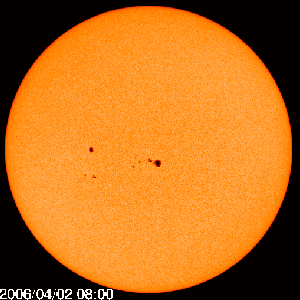First science

Two prominent spots are visible these days on the surface of the sun: the largest one (on the right) is called 865. The spots are numbered serially from the beginning of the year.
865 has developed into the biggest spot of 2006, (so far). The entire Earth can comfortably fit - about 10 times - within the area of the spot. 865 is expected to end its life as an M-class solar flare, an intermediate class that reflects the potential for mild radio interference on Earth.
The video provides an illustration of how tracking solar eclipses allows - among other things - to identify and measure the self-rotation of the sun.
Comments:
* The various sun images on this site involve filtering different wavelengths ("colors"). At each of the wavelengths other components of the sun are revealed.
* The film has a volume of about 5M. Preparing it for observation involves waiting for the charging to finish.
Sunspots - background in a "nutshell"
Sunspots were observed and recorded by Galileo as early as 1610, but daily monitoring of them began in 1749.
Sunspots are irregularities in the Sun's magnetic field. A significant part of the solar material found close to the surface is ionized and therefore carries an electrical charge. The presence of magnetic fields affects the trajectory of charged particles. An increased concentration of magnetic field lines in a certain area - creates the phenomenon known to us as sunspots.
865 is expected to end its life as an M-class solar flare, an intermediate class that reflects the potential for mild radio interference on Earth. In many cases, the release of the energy contained in the magnetic field at the origin of the spot - leads to a "solar eruption". The outbreaks may be reflected in significant disturbances to systems such as: communication and navigation satellites, national power grids, and more.
With simple tools - available to many eclipse watchers - the spots can be viewed
Observation options
With simple tools - available to many eclipse watchers - the spots can be viewed. A focused look using eclipse glasses, may allow - for the sharp-eyed among us - to notice spot 865.
An alternative, safe and effective method is projection using binoculars (see below the construction of a projector based on binoculars) after locating the image of the sun on the projection screen, the image must be carefully focused. Best focus is achieved when the edges of the sun image appear perfectly sharp. Already at small magnifications it is easy to locate spot 865. A long look will also reveal the other spots.
Main site of science
The solar knower
https://www.hayadan.org.il/BuildaGate4/general2/data_card.php?Cat=~~~441781978~~~12&SiteName=hayadan
